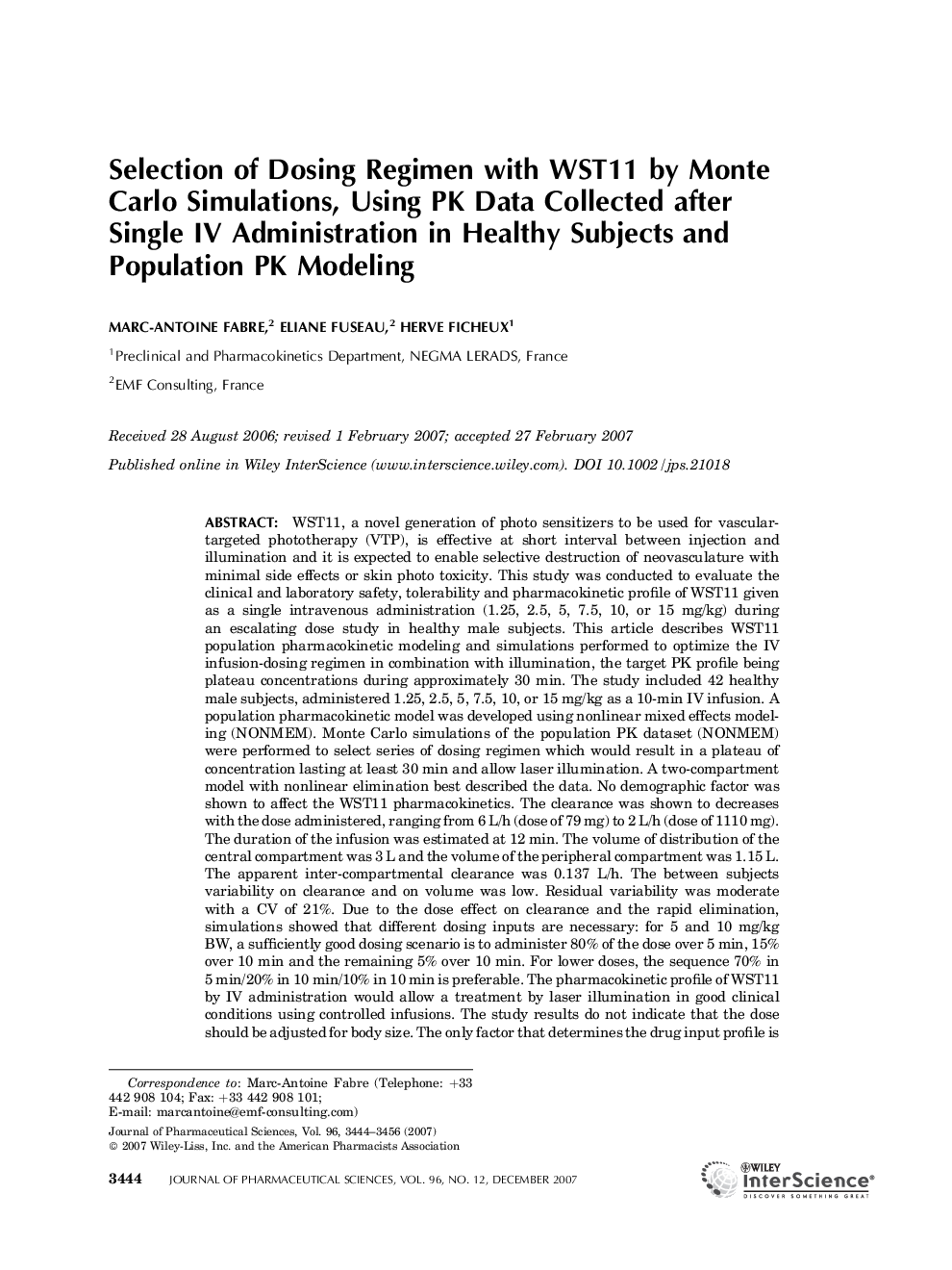| کد مقاله | کد نشریه | سال انتشار | مقاله انگلیسی | نسخه تمام متن |
|---|---|---|---|---|
| 2487641 | 1114424 | 2007 | 13 صفحه PDF | دانلود رایگان |
عنوان انگلیسی مقاله ISI
Selection of dosing regimen with WST11 by Monte Carlo simulations, using PK data collected after single IV administration in healthy subjects and population PK modeling
دانلود مقاله + سفارش ترجمه
دانلود مقاله ISI انگلیسی
رایگان برای ایرانیان
کلمات کلیدی
موضوعات مرتبط
علوم پزشکی و سلامت
داروسازی، سم شناسی و علوم دارویی
اکتشاف دارویی
پیش نمایش صفحه اول مقاله

چکیده انگلیسی
WST11, a novel generation of photo sensitizers to be used for vascularâtargeted phototherapy (VTP), is effective at short interval between injection and illumination and it is expected to enable selective destruction of neovasculature with minimal side effects or skin photo toxicity. This study was conducted to evaluate the clinical and laboratory safety, tolerability and pharmacokinetic profile of WST11 given as a single intravenous administration (1.25, 2.5, 5, 7.5, 10, or 15 mg/kg) during an escalating dose study in healthy male subjects. This article describes WST11 population pharmacokinetic modeling and simulations performed to optimize the IV infusionâdosing regimen in combination with illumination, the target PK profile being plateau concentrations during approximately 30 min. The study included 42 healthy male subjects, administered 1.25, 2.5, 5, 7.5, 10, or 15 mg/kg as a 10âmin IV infusion. A population pharmacokinetic model was developed using nonlinear mixed effects modeling (NONMEM). Monte Carlo simulations of the population PK dataset (NONMEM) were performed to select series of dosing regimen which would result in a plateau of concentration lasting at least 30 min and allow laser illumination. A twoâcompartment model with nonlinear elimination best described the data. No demographic factor was shown to affect the WST11 pharmacokinetics. The clearance was shown to decreases with the dose administered, ranging from 6 L/h (dose of 79 mg) to 2 L/h (dose of 1110 mg). The duration of the infusion was estimated at 12 min. The volume of distribution of the central compartment was 3 L and the volume of the peripheral compartment was 1.15 L. The apparent interâcompartmental clearance was 0.137 L/h. The between subjects variability on clearance and on volume was low. Residual variability was moderate with a CV of 21%. Due to the dose effect on clearance and the rapid elimination, simulations showed that different dosing inputs are necessary: for 5 and 10 mg/kg BW, a sufficiently good dosing scenario is to administer 80% of the dose over 5 min, 15% over 10 min and the remaining 5% over 10 min. For lower doses, the sequence 70% in 5 min/20% in 10 min/10% in 10 min is preferable. The pharmacokinetic profile of WST11 by IV administration would allow a treatment by laser illumination in good clinical conditions using controlled infusions. The study results do not indicate that the dose should be adjusted for body size. The only factor that determines the drug input profile is the dose level, since the elimination halfâlife decreases when the dose administered increases. The use of the population PK model for simulations has shown that, at dose level of 5 mg/kg or more, a loading dose of 80% dose given over 5 min followed by 15% of dose during 10 min and remained dose to give over 10 min would result in a favorable PK profile. © 2007 WileyâLiss, Inc. and the American Pharmacists Association J Pharm Sci 96: 3444-3456, 2007
ناشر
Database: Elsevier - ScienceDirect (ساینس دایرکت)
Journal: Journal of Pharmaceutical Sciences - Volume 96, Issue 12, December 2007, Pages 3444-3456
Journal: Journal of Pharmaceutical Sciences - Volume 96, Issue 12, December 2007, Pages 3444-3456
نویسندگان
MarcâAntoine Fabre, Eliane Fuseau, Herve Ficheux,